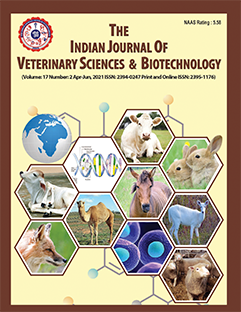Clinico-Therapeutic Management of Reticular Abscess due to Ruminal Acidosis in Jaffarabadi Buffalo – A Report of Four Cases
DOI:
https://doi.org/10.48165/ijvsbt.21.6.37Keywords:
management, consume, decreased milk yield, haematological analysis, guidanceAbstract
Reticular abscesses in buffaloes are a frequent complication of traumatic reticuloperitonitis or foreign body syndrome, primarily caused by the anatomical structure and function of the reticulum (Athar et al., 2010). These abscesses often result from foreign body penetration or bacterial infections, causing severe inflammation that can lead to toxaemia and heart failure if left untreated (Abu-Seida and Al-Abbadi, 2016). In addition to trauma, prolonged ruminal acidosis, often due to improper dietary management, is a significant contributing factor (Sharma et al., 2015). When ruminants consume high amounts of rapidly fermentable carbohydrates, such as grains, subacute ruminal acidosis (SARA) can occur, leading to a drop in ruminal pH and weakening of the rumen and reticulum walls, making them more susceptible to bacterial infections and abscess formation (Caldwell et al., 2011). This study documents the clinico-therapeutic management of reticular abscesses due to ruminal acidosis in Jaffarabadi buffaloes.
Downloads
References
Abd El Razik, W.M., Al-Abbas, M.A., Kotb, A.G., & Gouda, S.M. (2023). Uses of diagnostic ultrasonography in the diagnosis of some digestive disorders in cattle and buffalo. Journal of Advanced Veterinary Research, 13(3), 563–567.
Abu-Seida, A.M., & Al-Abbadi, O.S. (2016). Recent advances in the management of foreign body syndrome in cattle and buffaloes: A review. Pakistan Veterinary Journal, 36(4), 1–8.
Athar, H., Mohindroo, J., Kumar, A., Singh, K., & Sangwan, V. (2010). Diagnosis and surgical management of reticular abscess in bovines. Indian Journal of Veterinary Surgery, 31(1), 33–36.
Caldwell, D.R., Atkinson, J.A., & Jones, M.E. (2011). The influence of diet on reticulorumen abscess formation in dairy cattle. Journal of Dairy Science, 94(2), 672–680.
Chetan Kumar, G.K., Bhagya, B.K., Ashwini, A., & Sagar, R.S. (2024). Digestive disorders. Periparturient Diseases of Cattle, 12(1), 243–256.
Enemark, J.M.D. (2008). The monitoring, prevention, and treatment of subacute ruminal acidosis (SARA): A review. Veterinary Journal, 176(1), 32–43.
Garrett, E.F., Pereria, M.N., Nordlund, K.V., Armentano, L.E., Goodger, W.J., & Oetzel, G.R. (1999). Diagnostic methods for the detection of subacute ruminal acidosis in dairy cows. Journal of Dairy Science, 82(6), 1170–1178.
Hussain, S.A., Uppal, S.K., Mahajan, S.K., Sood, N.K., Randhawa, C.S., & Athar, H. (2024). Reticular abscess in buffaloes and cattle: Clinical-biochemical, diagnostic imaging findings, treatment and long-term follow-up. Comparative Clinical Pathology, 33(3), 425–436.
Makhdoomi, S.M., Sangwan, V., & Kumar, A. (2018). Radiographic prediction of metallic foreign body penetration in the reticulum of cows and buffaloes. Veterinary World, 11(4), 488–496.
Plaizier, J.C., Krause, D.O., Gozho, G.N., & McBride, B.W. (2008). Subacute ruminal acidosis in dairy cows: The physiological causes, incidence and consequences. Veterinary Journal, 176(1), 21–31.
Kumar, A., Sangwan, V., Mohindroo, J., Singh, S.S., Saini, N.S., Chachra, D., & Kaur, G. (2008). Diagnostic and prognostic indicators, antibacterial sensitivity pattern and surgical treatment of perireticular abscess in cows and buffaloes. The Indian Journal of Animal Sciences, 78(12), 1329–1332.
Saini, N.S., Kumar, A., Mohindroo, J., Singh, S.S., Anand, A., Mahajan, S.K., Raghunath, M., Chaudhary, M., Singh, N., & Toor, A.S. (2005). Clinical features and survival in reticular abscessation in buffaloes. Buffalo Bulletin, 21(2), 167–173.
Sharma, A.K., Dhaliwal, P.S., & Randhawa, C.S. (2015). Epidemiological studies on forestomach disorders in cattle and buffaloes. Veterinary World, 8(9), 1063.
Downloads
Published
Issue
Section
License
Copyright (c) 2025 Indian Journal of Veterinary Sciences and Biotechnology

This work is licensed under a Creative Commons Attribution-NonCommercial-NoDerivatives 4.0 International License.




